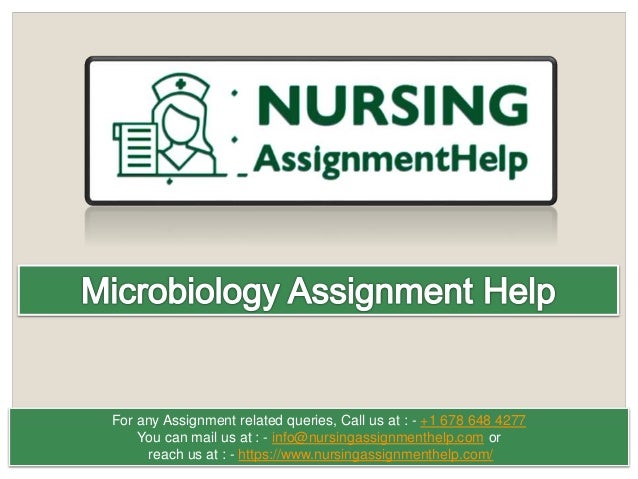
Microbiology Assignment Help
- 1. For any Assignment related queries, Call us at : - +1 678 648 4277 You can mail us at : - info@nursingassignmenthelp.com or reach us at : - https://www.nursingassignmenthelp.com/
- 2. Microbiology Systems Problem .1 Shiga toxin (Stx) is a potent A-B toxin that inhibits protein synthesis and has a lethal dose 50* (LD50) of approximately 20 ng/kg of body weight in rabbits (meaning that 1 µg of Stx would be lethal for half the people exposed to this dose). Nonetheless, cell lines derived from different mammalian tissues range from highly susceptible (cytotoxic dose 50† [CD50] of approximately 10 pg/ml) to completely resistant (CD50 > 1 µg/ml). What cellular or molecular differences do you think account for susceptibility and resistance of these cell lines. How could you test your hypothesis? *LD50 is the dose at which 50% of the test subjects die. In this case, it was determined for rabbits given intravenous injections of the toxin. † CD50 is the concentration at which 50% of the cells die. Different cell lines from different tissues will or will not express the receptor for the B subunit of the toxin. Without receptor expression the A subunit of the toxin will not get transported into the cytoplasm where it will be able to inhibit protein synthesis. This can be tested by administering the B subunit alone or the A subunit alone to determine the susceptibility of each cell line. Could also test for Gb3 content of the cells. nusingassignmenthelp.com
- 3. Problem .2 a. List and describe the important steps in selection and activation of a T-cell. Why are each of these steps important and what would be the consequences if they did not occur? Positive selection—T cells that DO interact with MHC proteins in the thymus divide and proliferate. Cells that DO NOT interact (bind) MHC die off. Important to ensure the TCRs will recognize the MHC, if they didn’t the cells would not be activated and would die. Negative selection—T cells that DO interact with self antigen and MHC in the thymus are killed. Cells that DO NOT continue to proliferate. Important to limit self-reactive T cells in the periphery that would cause massive autoimmune reactions. Activation in periphery—T cells that bind antigen-MHC complex and get second signal (CD28 binds to B7.1 or B7.2) become activated, proliferating and secreting cytokines as their specific effector functions dictate (depends on type of T cell) b. Specificity and tolerance are necessary for the adaptive immune response. What role does immune memory play? How does production and maintenance of memory cells benefit the host? Memory allows the immune system to recognize and respond more rapidly to a previously encountered antigen. Memory is valuable because it permits the system to more vigorously respond to subsequent encounters with the same antigen and thus more readily fend off an infectious disease or debilitating illness nusingassignmenthelp.com
- 4. Problem.3 a. Construct a table that lists the common features of proteins encoded by members of the Ig gene superfamily. For Igs, TCRs, and MHC proteins, identify the structural components that fit these common features. Ig gene superfamily protein members contain C domains that identify the proteins as members of the Ig gene superfamliy. These constant domains have homologous amino acid sequences and higher-order structure, whereas the variable domains present in immunoglobulins and TCRs, as well as the antigen binding domain MHC class I and MHC class II are not conserved. b. Describe the structural and functional differences among the five major antibody classes. IgM-m heavy chain, first Ig produced, mainly surface bound, secreted upon activation in pentameric form (early infection) IgD-d heavy chain, same antigen binding site as IgM, surface bound, abundant on memory B-cells IgG-g heavy chain, many isotypes, monomer, major class in blood, Fc regions bind Fc receptors on macrophages and neutrophils, only Ig able to breach placental barrier (Fc regions) IgE-e heavy chain, monomer, very high affinity (KA~1010L/mole) Fc receptor on mast cells (tissue) and basophils (blood), also binds Fc receptors on eosinophils IgA/sIgA-a heavy chain, main Ig in secretory fluids, monomer in blood and dimer in secretions, produced in mucosal-associated lymphoid tissue nusingassignmenthelp.com
- 5. c. Which class of antibody is the most prevalent? Why do you think this is/what advantage does this provide the host? Secretory IgA is the most prevalent immunoglobulin. It’s secretion to mucosal surfaces provides a line of defense against pathogens, toxins, and other foreign antigens that could potential harm epithelial cells or cross over the epithelial barrier to reach other organs. Problem 4. The following description is for MacConkey sorbital (SMAC) agar: Mode of Action Bile salts mixture and crystal violet largely inhibit the growth of the Gram-positive microbial flora. Sorbitol, together with the pH indicator neutral red, is used to detect sorbitol-positive colonies and turning them red in color. Sorbitol-negative strains, on the other hand, form colorless colonies. Is this a selective or a differential medium? Most commensal E. coli strains ferment sorbitol, while pathogenic O157:H7 enterohemmorhagic E. coli (EHEC) do not. What color do you expect each of these colonies to be on SMAC plates? SMAC plates are selective for gram negative bacteria and differential for EHEC strains (strains that do not ferment sorbitol). EHEC would be clear colonies, and commensal E. coli would be pinkish colonies. nusingassignmenthelp.com
- 6. Problem 5. What is the advantage of “humanizing” monoclonal antibodies for use as therapeutics? Explain how this modification makes the recombinant molecule more safe and/or effective than a native mouse monoclonal that has the same specificity. Humanized antibodies have the advantage that they will not be perceived as foreign to the human host. Antibodies from other hosts are typically recognized as foreign within a few weeks of treatment, thus the therapy only works for a limited time. Most therapeutic uses of antibodies are for extended periods of time, not only a few weeks, thus a treatment would need to be found after they non-humanized antibodies are recognized as foreign. nusingassignmenthelp.com
